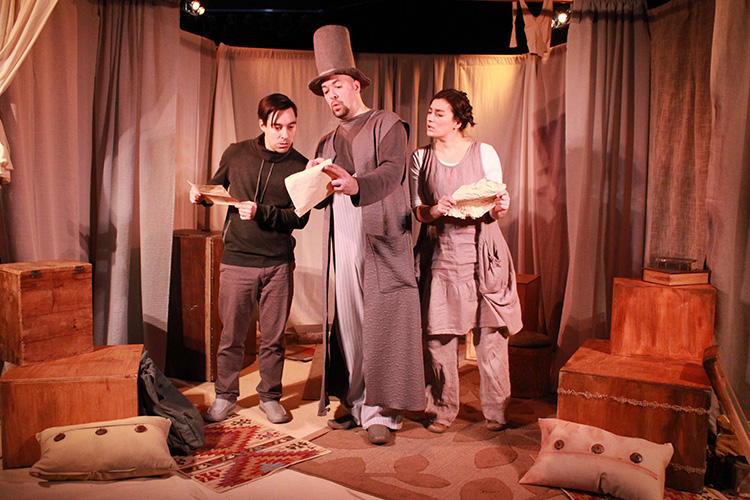Teaching our kids the joy of waiting

The cast of OGO, by Théâtre des Petites Âmes
Waiting is something my three-year-old does not want to do. This fact is expressed to me very bluntly on a daily basis, in his most logical voice, as if expressing a profound and surprising insight into his psyche: “Mommy – I don’t like to wait.” I hide a smile and always reply, “Oh?”
Theatre is all about anticipation and waiting, making it a challenging outing for a little one. There’s waiting to get there. Waiting for your tickets. Waiting for the theatre to open. Waiting for the show to start. Waiting for something to happen. All of these little micro-moments are an opportunity for attention to wander to a bright, shiny object. (A dump truck! A snack! A noisy hand dryer in the bathroom that nearly derails your morning!)
As I’ve noted before, the WeeFestival does a fantastic job keeping these little minds and bodies focused. There are crayons when you arrive; a calm vibe in the waiting area; artists who can deftly handle and channel the attention of their little attendees, with a fragment of song, a gentle voice, a magical promise of something special to come.
My first show of the festival this year was OGO, by Théâtre des Petites Âmes (Montreal). I brought Elliot, my three-year-old. It’s been almost a year since he saw his last play, at Fringe KidsFest last summer, and since then he has become one of those lithe, mile-a-minute preschool bodies, barely contained by the daily activity you try to wrap around him. But the minute we entered the theatre, he became almost monk-like in his quiet, with a finger to his lips in a gentle “Shush” – he knew we had entered a sacred space.
Little did I know that the play itself was about waiting – a meditation on what it means to wait, and the joy and surprise you can find if you allow yourself to wait PATIENTLY. (My most frequently used parenting word de jour.) In fact, I was pleasantly surprised to discover that the play was inspired by Waiting for Godot – something I discovered slowly as the performers revealed plot points that echoed the classic absurdist piece by Samuel Beckett. Instead of waiting for a man named Godot to arrive (or not) the performers were waiting for OGO, who we discover is a magical creature “with one blue eye and one green eye” who can transform from a large mischievous being who hovers in corners, to a tiny one that climbs around on minuscule ladders, to a fish-OGO who appears and disappears through a porthole into the ocean. OGO is always just out of grasp, and we catch glimpses of his next incarnation right before he’s gone – leaving the audience of kids whispering “Where is OGO?!”
As the performers search the nooks and crannies of the neutral-toned, textured set, they happen upon little surprises and gifts between OGO sightings. At one point, a wooden xylophone tumbles haphazardly out of a box; at another point a painting appears on a piece of linen that is stretched across the stage. The set is crammed full of textures and natural materials, just begging you to reach out and touch them. Small wooden boxes transform into cavernous escape routes, and a simple stool becomes the labyrinth of a spooky serpent-OGO. Every corner of the set contains a secret, a magical potential, and an opportunity to transform. At one point, bubbles float up from a box and Elliot can’t contain himself any longer: “It’s beautiful!” he shouts. After the play he says, “I want to come back here again and again and again.”
I never thought Godot would be suitable source material for a play for this age bracket, but it worked brilliantly well, and the kids connected to the performers’ predicament. I could almost hear the internal monologues of all the children: “Yeah, isn’t waiting the worst?!” But soon, once that pathway of empathy had been forged, the performers demonstrated that, hey, maybe waiting isn’t so bad after all. Maybe you don’t have to reach for a device to fill a moment. Maybe you can fill your waiting with something magical, because you never know where your imagination can take you.
At the end of the play, the performers are each left with a gift from OGO – a dainty little box that glows with a mysterious light when they open it. The box is inscribed with a message from OGO: whenever you need to get away, just open this box and I’ll be waiting for you. In other words, if you ever find yourself waiting around, filled with boredom or restlessness or sadness or fear, just open your imagination and I’ll take you anywhere you want to go.
